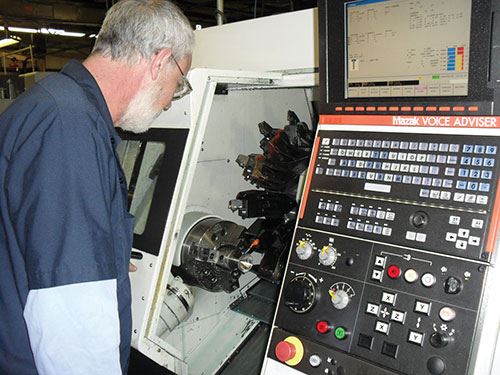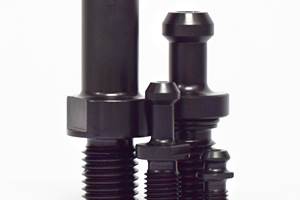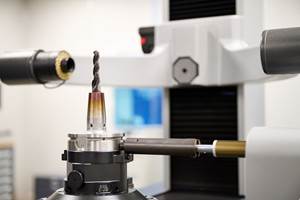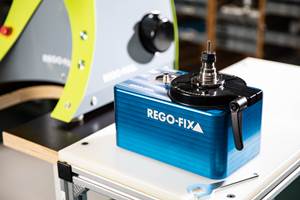Coolant-Fed Live Tools Increase Life in High-Cycle Operations
Using coolant-fed live tools from Planet Products helps shops increase productivity in high-capacity CNC turning applications.
Live tooling often features a sealed-bearing design to prevent coolant from entering the grease packing, but live tooling from Cincinnati, Ohio-based Planet Products uses the exact opposite approach. In fact, coolant is fed directly to the bearings to prevent overheating and tool failure during high-volume, lengthy-cycle CNC turning operations.
“If a shop produces items with long cycle times or high volumes, then thermal growth will usually occur in the toolhead,” explains Mike Thompson, lathe supervisor at Micro-Tronics (Tempe, Arizona). “This is because the sealed bearings in the toolhead tend to overheat during continuous use or under heavy loads, and that can cause serious problems.” Mr. Thompson says, Micro-Tronics’ precision machine shop has experienced a variety of sealed-bearing-related problems in the production of metal valves and related products for the aerospace and automotive industries. Among these problems was thermal growth, which caused offset deviations that adversely affected workpiece tolerances. In another instance, metal chips entered the toolhead after the bearing seal had failed.
To eliminate these issues, Micro-Tronics acquired a coolant-fed toolholder from Planet for each of its new Okuma LB300 lathes. Planet’s live-tool design for turret lathe applications uses a continuous flow of filtered machine coolant to lubricate and cool the bearings, reducing thermal growth. Unlike conventional bearings, coolant-fed bearings do not rely on seal integrity or the lubricant packing to operate normally in high-capacity conditions, the company says. Instead, the filtered coolant that externally cools and lubricates the live tools and workpieces flows through the tool to keep the bearings cool and maintain accuracy. Mr. Thompson adds that the coolant washes metal chips and other contaminants away from the bearing assembly before they cause damage. By keeping bearings cool and free of debris, the shop was able to increase tool life, and thus, increase productivity.
Another way that shops can increase productivity in high-capacity applications is by increasing production speed. Low-cost overseas competition makes this an especially important goal for Buku Performance Products, a small manufacturer of aftermarket components for radio-controlled vehicles. Dave Maslar, CEO of the Gambrills, Maryland-based business, turned to Planet to find a solution that could improve aluminum-cutting productivity on the company’s Puma 240 MB turret lathe from Doosan.
Cycle time for that aluminum component was approximately 6.5 minutes, more than four of which were occupied by cutting deep slots with a 3/32-inch end mill, Mr. Maslar explains. “The live-tool turret on my machine is limited to 5,000 rpm. That was the limiting factor for the time it was taking to process these components,” he says. To increase efficiency, Buku adopted Planet’s line of “speeder” over-speed heads, which feature a gear-up ratio that enables the tool to spin faster than the turret drive. For instance, a user with a 4,000-rpm turret could potentially increase turret speed to 12,000 to 15,000 rpm with a sped-up ratio. At Buku, the over-speed head reduced cycle time by more than 2 minutes. Even though the cycle time placed a heavy demand on the tool, reliability and accuracy were maintained, Mr. Maslar says.
The over-speed heads also feature coolant-fed bearings to reduce tool failure. “The bearings are running fast, and they are running for a long time,” Mr. Malsar says. “But having the coolant lubricate the bearings eliminated any concerns we could have had regarding overusing the live tool for that amount of time.” He adds that externally lubricated and cooled bearings can have tighter tolerances, which improves the runout characteristic of the bearing. Even though there is an upper limit to how tight the bearing tolerance can be if the tool is run for a long time, he attributes significant runout improvement to the active, external cooling and lubrication of the bearings in the tool head.
“That is a very important result because I’m running a 3/32-inch, three-flute end mill, and the feed per revolution is distributed among three cutting teeth,” he explains. Even the slightest bit of run-out can cause one tooth to substantially over-cut, wear faster and fail more quickly than it should. From a tool cost perspective, that might not be a big deal, he says, but from a production downtime standpoint, that can be very expensive. “So far, we’ve not broken one end mill, and that reflects cutting times of 20 to 30 hours on a single end mill.”
While Buku cuts aluminum, Mr. Maslar says that shops that cut very hard materials should have an even greater appreciation for the tool runout improvements because runout is usually a significant issue in pushing the limits of a hard milling operation.
Related Content
IMTS Takeaways From the Modern Machine Shop Editorial Team
The first in-person IMTS in four years left the MMS editorial staff with a lot to digest. Here are a few of our takeaways from the show floor.
Read MoreT.J. Davies Retention Knobs Maximize Cutting Tool Life
Custom-made retention knobs are sized to fit the machine tool and spindle or toolholder to extend the life of existing machine tool assets.
Read MoreSimulation and Tooling Secure High-Value Work
Simulation software and careful attention to tooling parameters have enabled Major Tool to take on ambitious projects with its complex machinery.
Read MoreFive Common Mistakes Shops Make with ER Collets (And How to Prevent Them)
Collets play a crucial role in the machining process, so proper tool assembly and maintenance is important. Here are five potential pitfalls to avoid when using ER collets.
Read MoreRead Next
3 Mistakes That Cause CNC Programs to Fail
Despite enhancements to manufacturing technology, there are still issues today that can cause programs to fail. These failures can cause lost time, scrapped parts, damaged machines and even injured operators.
Read MoreThe Cut Scene: The Finer Details of Large-Format Machining
Small details and features can have an outsized impact on large parts, such as Barbco’s collapsible utility drill head.
Read More










.png;maxWidth=300;quality=90)

















